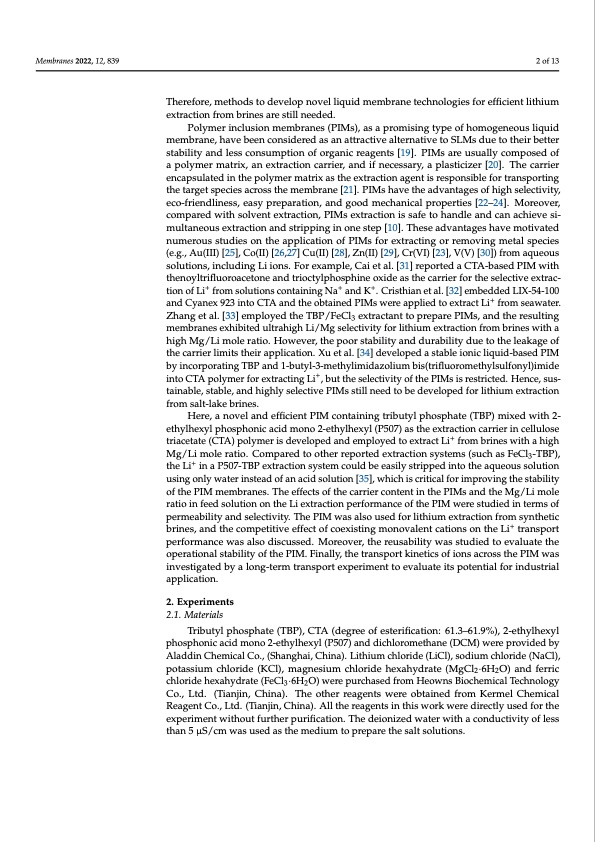
PDF Publication Title:
Text from PDF Page: 002
Membranes 2022, 12, 839 2 of 13 Therefore, methods to develop novel liquid membrane technologies for efficient lithium extraction from brines are still needed. Polymer inclusion membranes (PIMs), as a promising type of homogeneous liquid membrane, have been considered as an attractive alternative to SLMs due to their better stability and less consumption of organic reagents [19]. PIMs are usually composed of a polymer matrix, an extraction carrier, and if necessary, a plasticizer [20]. The carrier encapsulated in the polymer matrix as the extraction agent is responsible for transporting the target species across the membrane [21]. PIMs have the advantages of high selectivity, eco-friendliness, easy preparation, and good mechanical properties [22–24]. Moreover, compared with solvent extraction, PIMs extraction is safe to handle and can achieve si- multaneous extraction and stripping in one step [10]. These advantages have motivated numerous studies on the application of PIMs for extracting or removing metal species (e.g., Au(III) [25], Co(II) [26,27] Cu(II) [28], Zn(II) [29], Cr(VI) [23], V(V) [30]) from aqueous solutions, including Li ions. For example, Cai et al. [31] reported a CTA-based PIM with thenoyltrifluoroacetone and trioctylphosphine oxide as the carrier for the selective extrac- tion of Li+ from solutions containing Na+ and K+. Cristhian et al. [32] embedded LIX-54-100 and Cyanex 923 into CTA and the obtained PIMs were applied to extract Li+ from seawater. Zhang et al. [33] employed the TBP/FeCl3 extractant to prepare PIMs, and the resulting membranes exhibited ultrahigh Li/Mg selectivity for lithium extraction from brines with a high Mg/Li mole ratio. However, the poor stability and durability due to the leakage of the carrier limits their application. Xu et al. [34] developed a stable ionic liquid-based PIM by incorporating TBP and 1-butyl-3-methylimidazolium bis(trifluoromethylsulfonyl)imide into CTA polymer for extracting Li+, but the selectivity of the PIMs is restricted. Hence, sus- tainable, stable, and highly selective PIMs still need to be developed for lithium extraction from salt-lake brines. Here, a novel and efficient PIM containing tributyl phosphate (TBP) mixed with 2- ethylhexyl phosphonic acid mono 2-ethylhexyl (P507) as the extraction carrier in cellulose triacetate (CTA) polymer is developed and employed to extract Li+ from brines with a high Mg/Li mole ratio. Compared to other reported extraction systems (such as FeCl3-TBP), the Li+ in a P507-TBP extraction system could be easily stripped into the aqueous solution using only water instead of an acid solution [35], which is critical for improving the stability of the PIM membranes. The effects of the carrier content in the PIMs and the Mg/Li mole ratio in feed solution on the Li extraction performance of the PIM were studied in terms of permeability and selectivity. The PIM was also used for lithium extraction from synthetic brines, and the competitive effect of coexisting monovalent cations on the Li+ transport performance was also discussed. Moreover, the reusability was studied to evaluate the operational stability of the PIM. Finally, the transport kinetics of ions across the PIM was investigated by a long-term transport experiment to evaluate its potential for industrial application. 2. Experiments 2.1. Materials Tributyl phosphate (TBP), CTA (degree of esterification: 61.3–61.9%), 2-ethylhexyl phosphonic acid mono 2-ethylhexyl (P507) and dichloromethane (DCM) were provided by Aladdin Chemical Co., (Shanghai, China). Lithium chloride (LiCl), sodium chloride (NaCl), potassium chloride (KCl), magnesium chloride hexahydrate (MgCl2·6H2O) and ferric chloride hexahydrate (FeCl3·6H2O) were purchased from Heowns Biochemical Technology Co., Ltd. (Tianjin, China). The other reagents were obtained from Kermel Chemical Reagent Co., Ltd. (Tianjin, China). All the reagents in this work were directly used for the experiment without further purification. The deionized water with a conductivity of less than 5 μS/cm was used as the medium to prepare the salt solutions.PDF Image | P507 TBP Carriers for Lithium Extraction from Brines

PDF Search Title:
P507 TBP Carriers for Lithium Extraction from BrinesOriginal File Name Searched:
membranes-12-00839.pdfDIY PDF Search: Google It | Yahoo | Bing
Product and Development Focus for Infinity Turbine
ORC Waste Heat Turbine and ORC System Build Plans: All turbine plans are $10,000 each. This allows you to build a system and then consider licensing for production after you have completed and tested a unit.Redox Flow Battery Technology: With the advent of the new USA tax credits for producing and selling batteries ($35/kW) we are focussing on a simple flow battery using shipping containers as the modular electrolyte storage units with tax credits up to $140,000 per system. Our main focus is on the salt battery. This battery can be used for both thermal and electrical storage applications. We call it the Cogeneration Battery or Cogen Battery. One project is converting salt (brine) based water conditioners to simultaneously produce power. In addition, there are many opportunities to extract Lithium from brine (salt lakes, groundwater, and producer water).Salt water or brine are huge sources for lithium. Most of the worlds lithium is acquired from a brine source. It's even in seawater in a low concentration. Brine is also a byproduct of huge powerplants, which can now use that as an electrolyte and a huge flow battery (which allows storage at the source).We welcome any business and equipment inquiries, as well as licensing our turbines for manufacturing.| CONTACT TEL: 608-238-6001 Email: greg@infinityturbine.com | RSS | AMP |